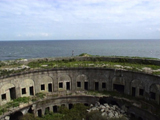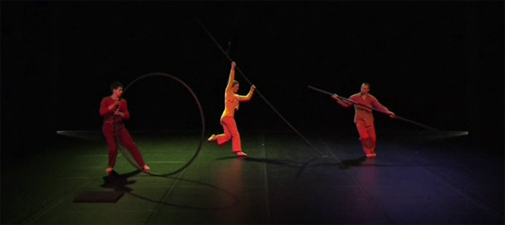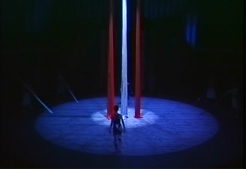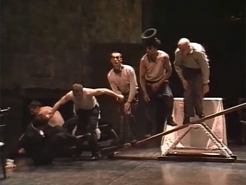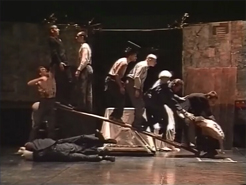by Jean-Michel Guy
The contemporary circus comprises extremely varied forms, seeks and produces no less diverse aesthetic effects and is based on distinct social values.
1. As far as form and format is concerned, we will note the following dominant trends: multi-disciplinary shows are the exception and no longer the rule. Each "circus art" including the most specific (corde lisse, diabolo, BMX, the Cyr wheel etc), gives rise to autonomous performances, mostly "small forms" (solos duos or trios), and sometimes "ensembles" combining a large number of artists from the same discipline. The preferred creative and performance space is a theatre, with a minority remaining attached to big top while others prefer "the street," or "non-show specific" spaces (museums schools, prisons). Others choose to communicate via film, video and digital and online diffusion. All lengths of format exist, even if certain standard times (20, 50 or 90 minutes) tend to be the norm. Audience formats – from a single spectator format to a performance for one thousand, or even more on the street – are also very varied.
Contemporary circus can also take on unusual forms: "collaborative" when the audience participates in the creation or performances; "experimental" when, for example, Marie-Anne Michel set up her Chinese pole in the middle of the desert, or Laurent Chanel walked for hours in ring-shaped spaces (hospital corridors, ramparts), or Kitsou Dubois took trapeze artists, jugglers and trampoline artists to work in a weightless environment, on aeroplanes or parabolic flights. In dramatic terms you will also see everything from simple shows with a unique focal point to rich and diverse shows with multiple focus points. "Pure circus" creations dealing with an issue directly inspired by the properties of a speciality discipline, or an apparatus, and minimal borrowing from other genres (dance, theatre, music) or in contrast, hybrid creations that seek to blend the different genres into a single "complete art" of narrative show ( verbal or non-verbal) and voluntarily "formal" or formalist forms of very "written" shows. Others leave room for much improvisation.
2. We can approach these aesthetics via a triple spectrum. In terms of distance from the norm, a continuum extends from the familiar (the real effect, the everyday and the plausible) to the strange (the absurd or monstrous), via the "effect of truth" that is much sought after today, and that we might call "authentic." In terms of emotions, the spectrum runs from laughter (of various types) to tears (poignant) via, mainly, the tender, gracious and dizzying and recently, a state of contemplation or meditation, on the border between pleasure and discomfort. In axiological terms – values of taste – ever-dominant novelty and the underlying originality (showing the author's character), compete with daring ("artistic risk taking" not physical danger), the strength and depth (of a propos), generosity (with regard to the audience), and by the two hazy yet powerful categories that are "poetry" and "writing."
3. The primary social function of the "contemporary" circus artist is to create and not to entertain. He sees himself therefore as an artist, in the sense that this word has acquired in the plastic arts – and seeks to be a part of the "history of art." But the economy of the performing arts and, in many countries, the low level of social and political recognition of the "circus as an art" generally obliges the artists to compromise (creating high-quality and accessible shows) or to apply for government aid, in the name of the "risk" (displeasing the greatest number, or displeasing full stop) that any creation entails. At the very least he requires the status of an author and for his creations that of a work, as the two notions are legally linked to that of originality. He also argues, as a performer, for social protection that is decent, or even, as in France dispensed by common law. His artistic (and social) aims however exceed by far the "expression of the self" as they range from "questioning" (which can make contemporary circus creation appear more intellectual than it really is), to an outright political stance (for a cause), via innumerable "socio-poetic" aims: to make the audience dream, to reconcile, move, astonish, and worry them, to share with them and also simply entertain them. Moreover, the "contemporary" artist has trained, except for some exceptions, at a circus school, and not within a family.
Contemporary circus is genetically diverse, blended and labile. Its cult of originality as a central value, ontologically prohibits all classification of works (by genre, trend etc) and all classification of the artists (by level, technique, originality etc.). It nevertheless tends to be structured by major socio-aesthetic forms corresponding more or less to market criteria according to the following polarities: popular/exclusive; "poor"/ "rich"; pure/indistinct; big top/theatre; onerous (technically, economically) / reasonable technical/artistic (old opposition inherited from competitive skating that has never been surmounted), familiar/exotic, etc.




